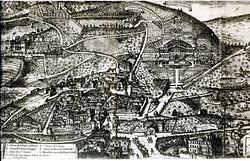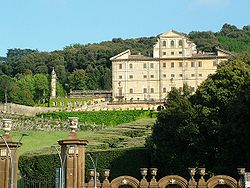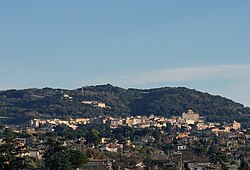|
Frascati
 Frascati (pronounced [fraˈskaːti]) is a city and comune in the Metropolitan City of Rome Capital in the Lazio region of central Italy. It is located 20 kilometres (12 mi) south-east of Rome, on the Alban Hills close to the ancient city of Tusculum. Frascati is closely associated with science, being the location of several international scientific laboratories. Frascati produces the white wine with the same name. It is also a historical and artistic centre. HistoryThe most important archeological finding in the area, dating back to Ancient Roman times, during the late Republican Age, is a patrician Roman villa probably belonging to Lucullus. In the first century AD its owner was Gaius Sallustius Crispus Passienus, who married Agrippina the Younger, mother of Nero. His properties were later confiscated by the Flavian imperial dynasty (69–96 AD). Consul Flavius Clemens lived in the villa with his wife Domitilla during the rule of Domitian. According to the Liber Pontificalis, in the 9th century Frascati was a little village, probably founded two centuries earlier. The name of the city probably comes from a typical local tradition of collecting firewood ("frasche" in Italian)—many place-names around the town refer to trees or wood. After the destruction of nearby Tusculum in 1191, the town's population increased and the bishopric moved from Tusculum to Frascati. Pope Innocent III endorsed the city as a feudal possession of the basilica of San Giovanni in Laterano, but in the following centuries its territories were ravaged by frequent raids that impoverished it. It was owned by various baronial families, including the Colonna, until, in 1460, Pope Pius II fortified the city with walls. At the beginning of the sixteenth century, Pope Julius II gave Frascati as a feudal possession to the condottiero Marcantonio I Colonna, who lived there from 1508 together with his wife Lucrezia della Rovere (1485–1552), niece of Pope Julius II. In 1515 Colonna gave Frascati its first statute, Statuti e Capituli del Castello di Frascati, under the Latin title Populus antiquae civitas Tusculi. In 1518 a hospital was built, named after St. Sebastiano, in memory of the old basilica destroyed in the 9th century. After Prince Colonna's death in 1522, Lucrezia della Rovere sold Frascati to Pier Luigi Farnese, nephew of Pope Paul III. On May 1, 1527, a Landsknecht company, after having sacked Rome, arrived out of the bordering villages. However, the soldiers changed the direction of their movement next to a niche, a "Rural Aedicule" consecrated to the Virgin Mary, and the town was therefore saved. This event is commemorated by a church now called Capocroce. In 1538, Pope Paul III conferred the title of "Civitas" to Frascati, with the name "Tusculum Novum". In 1598 construction began on a new cathedral dedicated to St. Peter. On September 15, 1616, the first public and free school in Europe was established on the initiative of Saint Joseph Calasanz.  On June 18, 1656, a part of the plaster peeled off a wall inside the Church of St. Mary in Vivario, and an ancient fresco became visible. It was the image of Saints Sebastian and Roch, protector from the plague. In that same year there was an epidemic of plague in Rome but Frascati was unaffected. Since that year, the two Saints have been co-patron Saints of the city. There are statues of the two saints in the façade of the Cathedral. Between 1713 and 1729, the head from a colossus of Antinous was discovered in the area, and displayed in the Villa Mondragone. In 1757 the Valle theater opened in the centre of the town, and in 1761 the fortress changed to a princely palace under the patronage of Cardinal Henry Stuart, Duke of York. In 1809 Frascati was annexed to the French Empire, and selected as the capital of the Roman canton. In autumn 1837, there was a plague epidemic in Rome, and 5,000 people left Rome. Frascati was the only city that opened its doors to them. Since then Frascati's flag has been the same as Rome's, yellow and red. In 1840 the "Accademia Tuscolana" was founded in the city by Cardinal-Bishop Ludovico Micara. In 1856 the city was chosen as the terminus of the Rome–Frascati railway, the first railway to be built by the Papal State. The last section of the railway line was opened in 1884, 14 years after the city became part of the new Kingdom of Italy. On December 17, 1901, Frascati started to receive electricity from a hydroelectric plant in Tivoli. In 1906, an electric tram line opened for service between Frascati, Rome and Castelli Romani. The trams traveled wholly along tracks laid down on existing streets as an interurban electric streetcar (light rail). In 1954 the electric tram line was replaced by buses. Another electric tram service, the Rome and Fiuggi Rail Road, called "Vicinali", was opened for service in 1916. It connected Frascati, Monte Porzio Catone, Monte Compatri and San Cesareo. This tram line was destroyed in 1943 and was replaced by buses. In 1943, during World War II, Frascati was heavily bombed because it contained the German General Headquarters for the Mediterranean zone. Approximately 50% of its buildings, including many monuments, villas and houses, were destroyed. One thousand Italians and 150 Germans died in that air strike[3] and in a second air strike on January 22, 1944, the day of the battle of Anzio (Operation Shingle). The city was liberated from the Nazi German occupation on June 4, 1944, by the 85th Infantry Division. In 1944–1945 the ruins of the buildings were used to fill in a valley, and that land now supports the "8 September Stadium". [clarification needed] Main sightsVillasFrascati is famous for its notable villas, which were built from the 16th century onwards by Popes, cardinals and Roman nobles as "status symbols" of Roman aristocracy. These country houses were designed for social activities rather than farming. The villas are substantially well preserved, or have been carefully and authentically restored following damage during World War II.  The main villas are:
 Religious sites
Museums
Twin towns – sister citiesFrascati is twinned with:[4]
Each year young people from Frascati and the other towns compete against one another in the Twin Towns Sports Competition, which is hosted in turn by each of the five towns. In the Torlonia Park in Frascati, there are roads named after each of the twin towns. Science laboratories During the latter half of the 1950s, the first Italian particle accelerator was developed in Frascati by INFN, and the INFN still has a major particle physics laboratory in the town, the Laboratori Nazionali di Frascati. Frascati now also hosts the following laboratories:
The OECD's Frascati Manual, a methodology for research and development statistics, originated from a meeting at the Villa Falconieri in June 1963. Literature and musicNovels and books partly or wholly set in Frascati include:
Some operas mention Frascati, including La Frascatana (L'Enfante de Zamora), 1774, by Giovanni Paisiello Notable peopleFrascati was the birthplace of:
Frascati has drawn many famous people to live there for a time including:
References
External linksWikivoyage has a travel guide for Frascati. Wikimedia Commons has media related to Frascati.
|
||||||||||||||||||||||||||||||||||||||||||||||||||||||||





